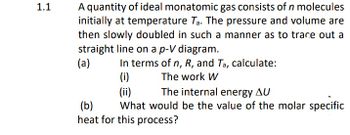Question

Transcribed Image Text:1.1
A quantity of ideal monatomic gas consists of n molecules
initially at temperature Ta. The pressure and volume are
then slowly doubled in such a manner as to trace out a
straight line on a p-V diagram.
(a)
In terms of n, R, and Ta, calculate:
The work W
(i)
The internal energy AU
(b)
What would be the value of the molar specific
heat for this process?
Expert Solution
This question has been solved!
Explore an expertly crafted, step-by-step solution for a thorough understanding of key concepts.
Step by stepSolved in 4 steps with 3 images

Knowledge Booster
Similar questions
- In a constant-volume process, 206 J of energy is transferred by heat to 0.97 mol of an ideal monatomic gas initially at 309 K. (a) Find the work done on the gas. (b) Find the increase in internal energy of the gas. (c) Find its final temperature.arrow_forwardLaws of Thermodynamics PLS ANSWER NO.2arrow_forwardIn a constant-volume process, 208 J of energy is transferred by heat to 1.07 mol of an ideal monatomic gas initially at 303 K. (a) Find the work done on the gas. (b) Find the increase in internal energy of the gas. (c) Find its final temperature. Karrow_forward
- Suppose 3.32 moles of a monatomic ideal gas expand adiabatically, and its temperature decreases from 371 to 254 K. Determine (a) the work done (including the algebraic sign) by the gas, and (b) the change in its internal energy.arrow_forwardA balloon holding 4.50 moles of oxygen (0,) gas absorbs 935 J of thermal energy while doing 112 J of work expanding to a larger volume. HINT (a) Apply the first law of thermodynamics. (b) Recall that the molar specific heat at constant volume, C, takes different values depending on whether the gas is monatomic or diatomic. Click the hint button again to remove this hint. (a) Find the change in the balloon's internal energy (in J). (b) Calculate the change in temperature of the gas (in K). Karrow_forwardA monatomic ideal gas expands adiabatically from 1.8 m³ to 4 m³. If the initial pressure is 102 kPa, calculate the energy in kJ transferred to or from the system by heat.arrow_forward
arrow_back_ios
arrow_forward_ios